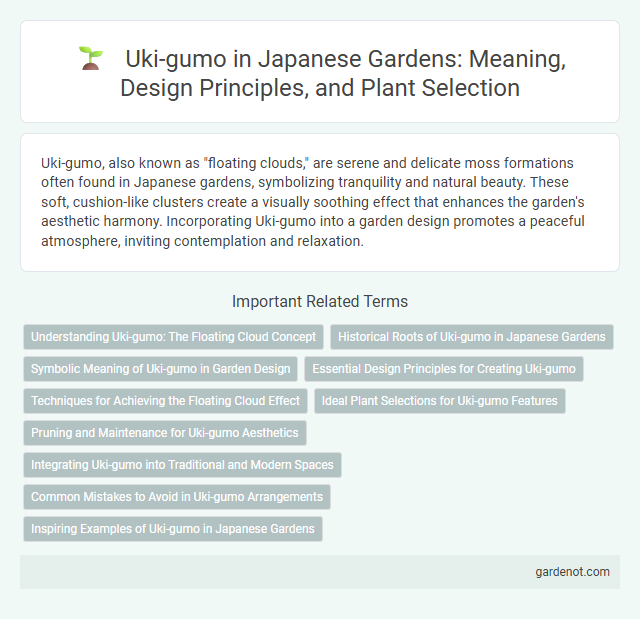Uki-gumo, also known as "floating clouds," are serene and delicate moss formations often found in Japanese gardens, symbolizing tranquility and natural beauty. These soft, cushion-like clusters create a visually soothing effect that enhances the garden's aesthetic harmony. Incorporating Uki-gumo into a garden design promotes a peaceful atmosphere, inviting contemplation and relaxation.
Understanding Uki-gumo: The Floating Cloud Concept
Uki-gumo, translating to "floating cloud," embodies the essence of transience and impermanence central to Japanese garden aesthetics. This concept reflects the delicate balance between natural elements, symbolizing the ethereal and ever-changing nature of clouds drifting effortlessly across the sky. By integrating Uki-gumo, garden designs create a harmonious blend of movement and stillness, inviting contemplation on the fleeting moments of beauty in the natural world.
Historical Roots of Uki-gumo in Japanese Gardens
Uki-gumo, a traditional floating cloud motif, traces its historical roots to Edo-period Japanese gardens where it symbolized impermanence and ethereal beauty. This design appears in water features and garden structures, reflecting the influence of Zen Buddhism and the aesthetic principles of wabi-sabi. Prominent gardens such as Ritsurin Park and Kenrokuen showcase Uki-gumo patterns, connecting contemporary garden artistry to centuries-old cultural symbolism.
Symbolic Meaning of Uki-gumo in Garden Design
Uki-gumo, meaning "floating clouds," symbolizes impermanence and the transient nature of life in Japanese garden design. Its delicate patterns evoke a sense of calm and ephemeral beauty, reflecting the Zen philosophy embedded in traditional garden aesthetics. This motif encourages contemplation and harmony between the natural and spiritual worlds.
Essential Design Principles for Creating Uki-gumo
Uki-gumo, a dynamic cloud formation utilized in Japanese gardens, emphasizes balance, harmony, and natural flow in its design, mirroring the transient beauty of clouds on water. Key principles include asymmetry to evoke natural unpredictability, the strategic placement of stones and plants to create depth and perspective, and the use of water elements to reflect and enhance the floating cloud motif. These elements collectively foster a serene atmosphere that invites contemplation and connection with nature.
Techniques for Achieving the Floating Cloud Effect
Uki-gumo, a traditional Japanese garden technique, achieves the floating cloud effect by carefully layering moss, stones, and carefully pruned shrubs to create an illusion of drifting clouds. This method emphasizes the subtle interplay of light and shadow while maintaining natural asymmetry to evoke a serene, ethereal atmosphere. Mastery of spatial depth through varying plant heights and textures enhances the three-dimensional perception, making the garden appear expansive and tranquil.
Ideal Plant Selections for Uki-gumo Features
Ideal plant selections for Uki-gumo features emphasize delicate foliage and subtle textures that complement the garden's serene atmosphere. Japanese maples, mosses, and ferns create a calming palette, enhancing the soft, cloud-like appearance suggested by Uki-gumo's name, meaning "floating clouds." Incorporating azaleas and bamboo provides seasonal color variation and structural contrast while maintaining harmonious balance within the traditional Japanese garden aesthetic.
Pruning and Maintenance for Uki-gumo Aesthetics
Precise pruning techniques are essential for preserving the delicate, cloud-like forms of Uki-gumo trees, enhancing their layered foliage and airy appearance. Regular maintenance involves selective trimming to promote healthy growth while maintaining the characteristic rounded shapes that define Uki-gumo aesthetics. Consistent care ensures the balance between natural beauty and artistic structure, a hallmark of traditional Japanese garden design.
Integrating Uki-gumo into Traditional and Modern Spaces
Uki-gumo patterns seamlessly blend with both traditional Japanese garden elements and contemporary landscape designs, enhancing the visual harmony and tranquility of the space. This cloud motif, characterized by its fluid, floating forms, complements natural features such as stone lanterns, water basins, and manicured trees while adding a modern artistic touch to minimalist pathways and seating areas. Incorporating Uki-gumo into garden architecture fosters a cohesive aesthetic that respects cultural heritage and embraces innovative design trends.
Common Mistakes to Avoid in Uki-gumo Arrangements
Common mistakes to avoid in Uki-gumo arrangements include overcrowding the design, which disrupts the intended balance and tranquility characteristic of Japanese gardens. Using incompatible plant species or neglecting seasonal changes can lead to a loss of the cloud-like, floating effect that Uki-gumo aims to evoke. Failing to maintain precise pruning techniques compromises the structural harmony essential for achieving the delicate, layered appearance typical of Uki-gumo patterns.
Inspiring Examples of Uki-gumo in Japanese Gardens
Uki-gumo, or "floating clouds," is a distinctive pruning technique in Japanese gardens that creates fluffy, cloud-like shapes from pine branches, enhancing the garden's ethereal and tranquil atmosphere. This method emphasizes asymmetry, balance, and natural flow, inspiring garden designers worldwide to incorporate sculptural elements that evoke calm and contemplation. Renowned gardens such as Ritsurin Garden and Kenroku-en showcase Uki-gumo to highlight traditional aesthetics and seasonal transitions, making it a timeless symbol of Japanese horticultural art.
Uki-gumo Infographic

 gardenot.com
gardenot.com